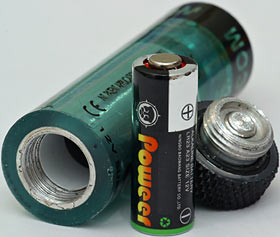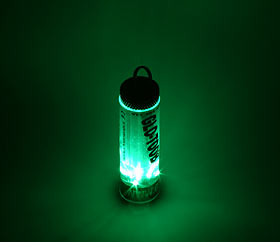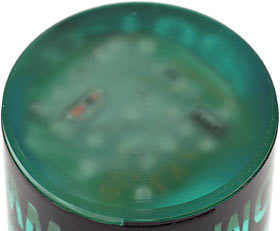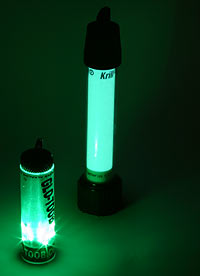
Glo-Toob FX
Review date: 14 October 2003.
Last modified
03-Dec-2011.
The chemical glowstick is cheap, and simple, and useful, and under siege.
There are some features of chemical glowsticks that electronic alternatives have a hard time matching. Cheapness, in particular, and toughness too. But electronic glowsticks can be turned on and off whenever you like, don't go stale over time (OK, alkaline batteries will eventually die on the shelf, but modern ones aren't likely to leak catastrophically, so you can just change them), and are also likely to be brighter than all but the most psychotically short-lived chemical sticks.
If you want a "marker light" - something bright enough to light a whole room well enough that you won't walk into the furniture, but nothing more - then a dim electronic glowstick like the electroluminescent Krill sticks I review here will do the job, provided you don't want a super-cheap leave-it-behind light.
The above review also covers some super-cheap LED-based alternatives from PsychoLights, though. They aren't anything like as solidly made as the pricey Krill sticks, but their single LEDs out-glow the Krill products by a wide margin, at least while the little button cells powering the LEDs last.
Electroluminescent material has its advantages, but it's just not bright or efficient enough to compete with LEDs.
Hence, this.
It's a Glo-Toob FX. Basic Glo-Toobs just, well, "Glo", but the FX has some other tricks up its sleeve.
Physically, a Glo-Toob is a roughly 70mm long gadget composed of an epoxy slug with a screw-on knurled aluminium cap on one end. Under the solid epoxy, there's a turned aluminium core, the tapered base of which serves to reflect outwards the light from three unremarkable LEDs, which are mummified in the epoxy.
The whole assembly is absurdly solid, to the point that the manufacturers rate it as being "waterproof to any depth". It's pressure rated to 3,500 metres (11,500 feet).
That's about 350 atmospheres, people.
For reference, diving below 300 feet with SCUBA gear is pretty darn challenging, and getting below 1000 feet is world record material. People have gone a lot deeper, but not just flippering along with a little light attached to their belt.
The Glo-Toob's astounding pressure rating isn't important for people who don't intend to take it any deeper than sea level, of course, but its basically un-hurtable nature means that it should survive the most exciting activities of the most demanding users.
Krill glowsticks are tough, but I think you could shoot a Glo-Toob out of a cannon, and watch it work as a tracer.
Despite its toughness, it's easy to open the Toob. You just unscrew the end. Inside, there's a single LR23/A23 type 12 volt battery, as seen in car alarm remotes and various other small gadgets.
I'll get to the battery in detail in a moment. For now, I'll just point out that this really is a "battery", not just one cell. It gets its 12 volt potential because inside it there are eight minuscule LR932-size button cells, at 1.5 volts each.
Common nine volt batteries work the same way; the good ones are built from six skinny tubular "AAAA" cells, as I demonstrate here. The bad ones have crummier rectangular cells inside.
As with 9V batteries, the price LR23s pay for their high terminal voltage is lousy capacity.
The Toob's end cap is a clever piece of design. The threads around the outside are what hold it in place (there's an O-ring on the cap to seal it), but the centre part screws in and out as well.
That's the switch. You screw it in to turn the Toob on. Screw it in all the way and the split ring digs into the body of the cap and locks the Toob "on"; screw it out all the way and the threads bind firmly enough that it ought to stay "off", regardless of abuse. If you unscrew the switch too enthusiastically then you'll unscrew the whole cap with it, but it's easy to judge the right place to stop.
The Toob's light pattern is quite even, despite the three discrete lamps inside. It's not as smooth as the Krill sticks' output, but it's more than good enough for tent-lighting duty. It's also bright enough to be useable, in a pinch, as a task light; it's not ideal, but you can hold the Toob sideways in your mouth while you're doing something.
The printing on the side of the Glo-Toob, by the way, is a see-through sticker. You can peel it off if you want an unadorned (and slightly brighter) Toob.
(I've done that now, with my review Toob. It was easy, except the label left all of its adhesive on the body of the Toob, and I had to clean it off with alcohol.)
Both plain and FX Glo-Toobs come with red, amber, blue, green or white LEDs. As you may have noticed, I got a green one for review.
Doing tricks
The Glo-Toob FX isn't just a simple on-off light; there's a little controller board in there, vaguely visible through the tinted epoxy.
The FX's seven modes of operation are described on the manufacturers' page for it, as is the ingenious way they've made it possible to select these modes when the only control you've got is its power switch.
The switching isn't as simple as just turning a selector dial, but it's still not very complex, and the flash and pulse modes are useful for marker-light purposes. The "25% constant on" low power mode is also welcome. That little 12 volt battery could do with a break.
As with many other LED lights that're capable of running at less than full brightness, the FX's 25% mode actually flashes the LEDs rapidly, rather than turning down their input voltage. Voltage-drop brightness control is difficult to implement efficiently; rapid-flashing isn't.
Wave the FX around when it's in 25% mode and you'll be able to see it flicker.
Power, in and out
The Glo-Toob FX outshone, easily, the brightest Krill glowstick I've got. That's the one that leaves its electroluminescent material in natural green, rather than dimming it with colour-shifting phosphors.
Here the Glo-Toob is in its 25% mode, with the bigger Krill stick doing its best in the background. The Toob is only casting a faint shadow behind the Krill stick, but a significant proportion of the light you think you're seeing from the Krill is actually reflected Toob-light.
Now, the Toob's on at full power. A shorter exposure makes the Krill stick look dimmer, which it is.
Putting the Krill stick ten centimetres from the sensor of my light meter gave a reading of two lux. About 50 lux is unremarkable in a normally lit night-time room.
Even in 25% mode, the Toob managed around 6 lux at 10cm, or about 9 lux if held at an angle so one of the brighter bands in its output hit the sensor.
At full power it managed 20 to 24 lux; better than 40 lux, if aimed at the sensor.
The "Extreme" versions of the Krill lamps are almost twice as bright as the regular ones, but they're still obviously not in the same league as the Glo-Toob.
The Toob doesn't have it all its own way, of course. It's powered by one tiny battery, while the Krill sticks use two relatively enormous AAs.
Duracell call the LR23 battery an MN21; Eveready call it an A23 - PDF data sheet here. That data sheet tells you that the Eveready A23 has a capacity of only 40 milliamp-hours (mAh) - and that's down to a 6V cutoff and from a 20,000 ohm load. At 12 volts, only 0.6 milliamps will flow through a 20 kiloohm load. Wind up the current to LED-light levels and you're not being kind at all to an LR23.
Even ignoring voltage sag, 12 volts times 40mAh gives a mere 0.48 watt-hours of energy. Two cheap alkaline AAs are likely to deliver more than seven watt-hours.
Now, EL material is rather less efficient than LEDs (generally less than ten lumens of light per watt of input power, versus an easy 20 to 30 LPW for coloured LEDs), but it's not that much less efficient. There's no way the Glo-Toob can last as long on an LR23 as a Krill stick can on two AAs.
Running at 12 volts from my bench supply, the Glo-Toob sucked about 15 milliamps (mA) in 25% mode, and more than 90mA in full power mode.
Even 15mA is a pretty steep load for an LR23. The battery's output voltage will sag as a result, and the current consumption will go down with it, reaching a gently diminishing state of equilibrium a fraction of a second after turn-on. The Toob's full power mode is the same, only more so. It's much crueller to the battery than 25% mode, but I doubt a Glo-Toob running from an LR23 can actually draw even 50mA for more than a tiny fraction of a second.
The manufacturers rate Glo-Toobs as being good for 30 hours of run time, and I think that's fair, provided you apply the Photon Light Caveat. Yes, LED lights that run from dinky little batteries often have excellent battery life, but they're much, much dimmer at the end of that life than they are at the beginning. Still the same colour, but not nearly as bright.
30 hours isn't really stretching the Glo-Toob's likely full-power run time from a decent LR23; twiddling the output of my bench supply revealed that it could still make better-than-nothing light from about seven input volts, and glimmered at around six volts. This means that even fussy users should get about a straight day of worthwhile light at full power, and three or four days at "25%" should be possible too.
Buying one
Various dealers sell plain Glo-Toobs; expect to pay something around 30 US bucks plus shipping. As usual, cheap dealers are more likely to have shipping and handling fees that cancel out the discount.
The Glo-Toob FX is a bit harder to find; expect to pay at least $US10 more.
Overall
Krill glowsticks - even the new models with a red LED in one end - will only set you back around $US25, and there are better options than the Glo-Toob if you just want a "tent light", and don't anticipate getting caught in a war zone.
If you have a use for a Glo-Toob, though (the PR material lists divers, soldiers, emergency services personnel, boaters, climbers, hunters and fisherpersons as being among those who may need one), there's really nothing like it. The FX is particularly remarkable. It's a long-lasting marker light that flashes, and is small enough that you can stuff two into the Zippo pocket of your jeans.
Glo-Toobs are, unquestionably, weird little specialised things that the average human can readily live without. But you'll know if you need one. And I rather like playing with mine.
Review Glo-Toob FX kindly provided by Glo-Toob.










